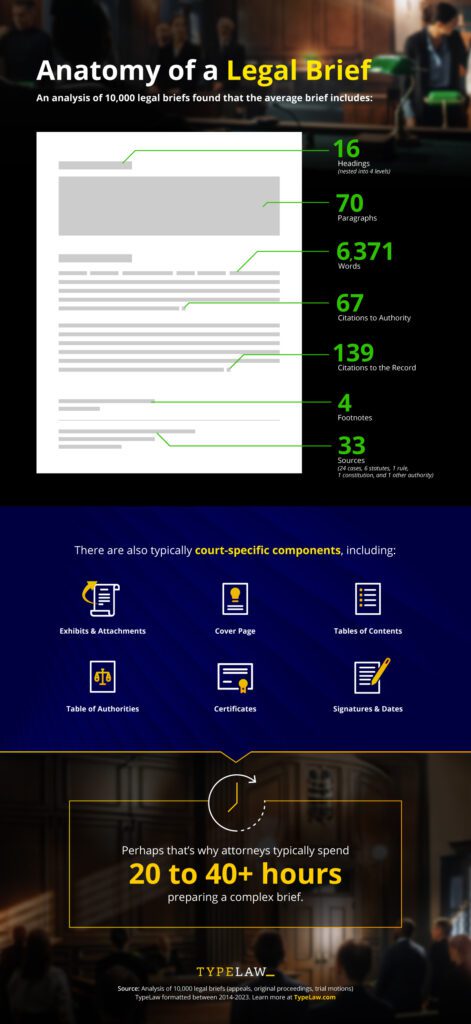Efficiency and precision are both vital when crafting a legal brief, but attorneys can get bogged down in the details and end up wasting valuable hours on formatting minutiae.
It’s a tricky balance to get right.
You need to focus your time on sharpening your argument, but if your brief doesn’t meet all local rules of court, it won’t be as effective…and could even be rejected come filing time.
TypeLaw’s Co-founder & CEO, Chris Dralla, recently discussed this challenge with Bob Ambrogi on the LawNext podcast (listen on Spotify or Apple Podcasts).
Why does it take so long to accurately format a brief?
We analyzed the composition of 10,000+ legal briefs, appeals, original proceedings, and trial motions that TypeLaw has helped attorneys prepare and found that the average brief contains:
- 6371 words
- 16 headings (nested into 4 levels)
- 70 paragraphs
- 4 footnotes
- 33 sources (24 cases, 6 statutes, 1 rule, 1 constitution, and 1 other authority)
- 67 citations to authority
- 139 citations to the record
As the below infographic highlights, briefs also typically include other court-specific components that must be carefully formatted to meet exacting local rules, including the:
- Cover page
- Table of contents
- Table of authorities
- Certificates
- Exhibits and attachments
- Signatures and dates
Infographic: The Anatomy of a Legal Brief

Since technical errors can put a brief at risk of being rejected, it’s not uncommon for attorneys to spend between 20 and 40 hours or more on a complex legal brief, including drafting, formatting, and editing.
It’s not uncommon for attorneys to spend 20-40+ hours on a complex legal brief, including drafting, formatting, and editing.
“When I was a practicing attorney, the time I spent preparing Tables of Contents and Authorities were some of the most painful hours—often late at night under deadline pressure,” notes TypeLaw co-founder and CEO Chris Dralla. “Tables take a lot of time to create and manually update as you edit your brief. One small citation change or adding a new section can result in hours of tedious rework, if you’re not using software that automates the process.”
The brief drafting & editing process
The brief drafting process typically involves researching the law, reviewing relevant documents and evidence, and outlining and organizing the arguments. This can take several hours, or even days, depending on the complexity of your case and the amount of research required.
The editing process involves revising and refining the arguments, ensuring accurate, properly hyperlinked citations and formatting, and ensuring that the brief is well-written and persuasive. This process can also take several hours or even days—particularly for complex appellate briefs that require careful attention to detail.
Use AI-automation for fast, accurate brief formatting
The Anatomy of a Brief research really underscores how much time and effort goes into preparing a typical brief. It’s something you probably don’t think about as you’re in the thick of it, but it’s costing you, and/or your paralegal, hours of unnecessary stress and frustration.
AI automation can help you redirect time and focus on your argument, instead of the specific rules for each jurisdiction, to help you quickly produce a clean, compliant brief that signals to the court, and to opposing counsel, that you are well prepared.